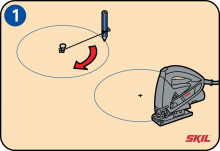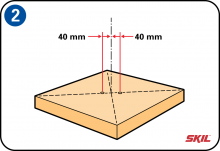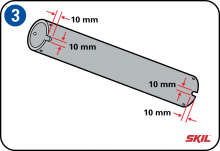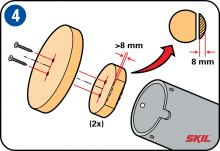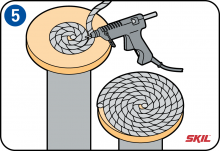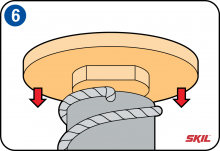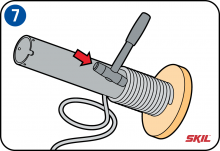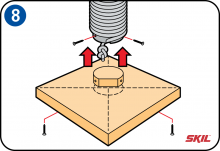-
Make the top plate of the scratching post
To make the top plate, use a 22 mm thick plywood panel. Use the jigsaw to saw out the round top plate with a diameter of 300 mm. You can mark out an accurate circular shape by driving in a nail at the centre of the panel, and then using a pencil and a piece of string to draw a circle at a distance of 150 mm from the centre. Smooth the edge with sandpaper to remove sharp edges and splinters.
-
Make the baseplate of the scratching post
To make the baseplate, use the same 22 mm thick plywood panel and saw out a square piece measuring 400 x 400 mm. If your cat is a bit heavier than average, you can make a double-thickness (44 mm) baseplate for extra stability. Locate the centre of the baseplate by drawing two lines between the opposite corners. Mark out 2 reference points on opposite sides of the centre, each at a distance of 40 mm from the centre. Drill 2 holes at those reference points. These holes will let you fix the baseplate to the tube using countersunk screws. Smooth all edges with sandpaper to remove sharp edges and splinters.
-
Korak nasvet
To make the tube even more stable, you can fill it with something heavy such as sand or gravel in small bags. -
Prepare the central tube of your cat scratching post
Cut out a 10 mm slot at each end of the PVC tube for the 8 mm sisal rope to pass through. Drill 3 small holes at the top and bottom of the tube so you can fix the top plate and the baseplate to the endplates in the tube.
-
Make the endplates
You need to make 2 endplates to fix the top plate and the baseplate inside the PVC tube. For these endplates, use a piece of 22 mm thick plywood. The diameter of the endplates is 110 mm (the outside diameter of the PVC tube) minus 2x the wall thickness of the tube. This is usually 3.2 mm, so the diameter of the endplates is (rounded-off) 103 mm. To make the 2 circular endplates, follow exactly the same method as for the top plate, and saw the 2 endplates out with the jigsaw. To allow you to pass the knotted sisal rope downwards through the endplate at the top of the tube, saw a piece with a width of 8 mm off the edge of this endplate. Then, fix the top plate to the endplate inside the top of the tube using screws and glue. Fixing the endplate inside the bottom of the tube is described later.
-
Cover the top plate
You can cover the top plate of your cat scratching post with the same kind of sisal rope that you used to wind around the PVC tube – your cat will like that! Just wind the sisal rope in circles and fix it to the top plate with glue.
-
Fit the top plate
Start at the top of the scratching post. Make a tight double knot at the end of the sisal rope, and place the rope in the PVC tube through the cut-out slot at the top end of the tube. Insert the endplate inside the top of the tube, with the sawn-off edge of the endplate next to the place where the rope passes through the cut-out slot in the tube. Press the endplate right into the tube, and then screw it in place with 3 countersunk screws. Make sure you fix the endplate so the top edge is horizontal and level with the top of the tube.
-
Wind the rope around the tube
Pull the rope tight and start winding it around the tube. Keep the rope tight while you’re winding it. After you’ve wound a few turns, use a hammer to push the windings tightly and neatly together. Use working gloves to protect your hands, and get someone else to help you to keep the rope tight. If you need to rest for a few minutes, you can fix the rope in place with a piece of tape.
-
Korak nasvet
Before you start to wind the rope, take a good look at how it unwinds. That will help you to avoid irregular windings. -
Fit the baseplate of the scratching post
When you’ve finished winding the rope around the tube, keep the rope tight and push it through the cut-out slot in the bottom end of the tube, in the same way as you did at the top of the tube. Press the endplate right into the bottom end of the tube, and then screw it securely in place. Make sure you fix the endplate so the bottom edge is horizontal and level with the bottom of the tube.

